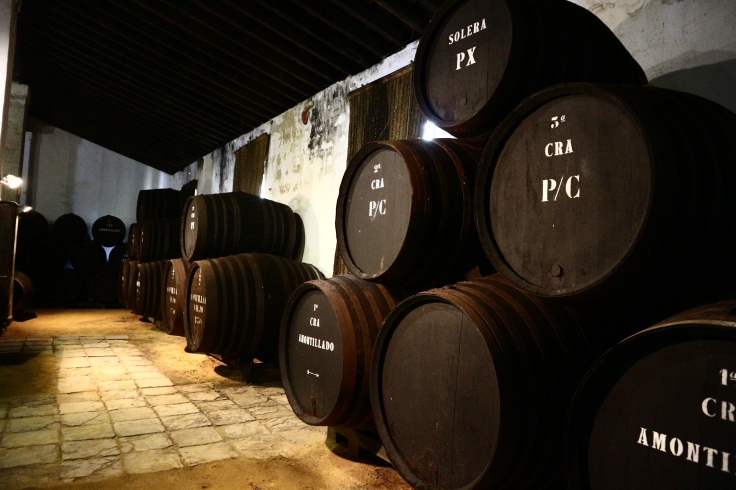In this hyper-accelerated world we are told that you must either adapt to the new ways or perish; adapt to new technology, new fads and new tastes, but for Bodegas Maestro Sierra, there is wisdom in the old ways. The naturality of a product, the care in its production and the honesty in its presentation may be seen as outdated shibboleths in this twenty-first century, but at Maestro Sierra, well, call them old-fashioned…
Entering the dark old sherry warehouses in Jerez’s San Miguel barrio, a friend and I were welcomed in by a man by the name of Cayetano, Maestro Sierra’s cellar master. Battling with an early-autumn cold, the capataz tells us, having a jab at some of the more well-known bodegas, that his real job isn’t to put on a clean-cut suit and a cordobese hat every day to give these tours, but to handle the day-to-day running of the cellar; taking care of the barrels and bottles in boots and overalls. The whole place, in fact, is run by a staff of two: himself and another off-hander. Hard times in Spain and even harder ones in Jerez have meant that the bulk of the warehouse work – once born by a team of five workers – now rests upon the shoulders of this duo. Others handle the exports and local sales, serving wine by the litre to local damas and caballeros, chattering ladies and slacks-wearing gentlemen who shuffle on in to fill up on the golden, honey, caramel coloured drops of the Maestro Sierra.

The owner of this winery, Doña Pilar Plá Pechovierto, refuses to close the doors of the bodega to the locals, arguing that it is Jerez and Jerezano oenophiles that are at the core of this business’ identity. Some of them, we are told, have been purchasing direct from the barrels for the entirety of the lives, doing the same as their parents and grandparents and great-grandparents have done for nearly two hundred years. “Can’t be a bad drop…”, I speculate.

Takin a languid stroll through the bodega, we learn that the wine is produced nearly entirely by hand, with the only piece of machinery being a small motor used to gently pump the wine from barrel to barrel in the solera system of maturation, a system which mixes old wines and new over decades and centuries. How do they know when to cut the motor off as each barrel is being filled with fresh sherry? By ear, of course; an accurate measure with time and practise but a dangerous one for first timers; Ceyetero got it very wrong when he first started working here, causing the barrels to overflow with wine (in any other situation barrels overflowing with fino would be a blessing).
Once they have their wine matured and ready for bottling, no extra chemicals need be added for filtering; here only egg whites are used, just as they did an age ago. After happily enjoying a bottle of fino over some seafood tapas, your head will thank Maestro Sierra for insisting on egg-whites; the chemicals used in other wines can be head-ache inducing and hangover enhancing. Once filtered, the cellar master and his offsider bottle and label the wines themselves, using an instrument which he insists is the most important tool of them all; the hammer. He bangs in the cork and slaps a label on the side to mark the specific bottle and lot number; then the day is done.
Yes, things in Maestro Sierra are pretty simple, but there are a couple mysteries which can’t quite be explained. Amongst the hundreds of barrels sitting in file, occasionally one wine will break free of conformity and a palo cortado will miraculously appear, a wine which oenologists still struggle to explain. You cannot just ‘make’ a palo cortado, Cayetano tells us, though some producers, he suspects, tempted by the massive demand for palos, do disingenuously mix two types of sherry to produce an imposter. But despite the enormous demand for this hybrid sherry, there is only so much palo cortado that Sierra Maestro can produce, pushing up its price on the wine-shop shelf. But for the less-well-resourced connoisseurs, there is always the despacho de vinos, the wine desk, where you can purchase the same wine for but a few euritos a litre (thank you, Doña Pilar..).
With several bottles lined up for tasting in front of us, and with said several bottles steadily emptying, one from our group asks our host whether working with wine day-in day-out takes away some of the charm and mystery from sherry. With the question barely finished, the man unhesitatingly responds “No!” He goes on: “Of course not. Because I am like the wine, because I too am in crianza, you see…”; crianza being the maturation process. So too is this old bodega, but there comes with age a certain wisdom, depth and self-assuredness that the young eschew for marketing smarts, sales, and fashion. Maestro Sierra proves that yes, sometimes the old ways really are better. With the tour over, my friend and I return home with a two-litre flagon in toe, and on a roof-top terrace overlooking Jerez we raise a glass to tradition, a toast to Maestro Sierra: ¡Salud!
Want to learn more about sherry?
If you’d like to read more articles like this one, please subscribe to the page in the section to the right, or check out already published articles under the Sherry Series tab in the menu.
This article was first published at www.sherry.wine









